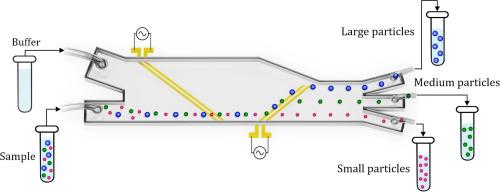聚合微通道中高纯度基于depa的多目标颗粒分离
IF 6.3
3区 工程技术
Q1 ENGINEERING, CHEMICAL
Journal of the Taiwan Institute of Chemical Engineers
Pub Date : 2025-09-30
DOI:10.1016/j.jtice.2025.106431
引用次数: 0
摘要
介质电泳(DEP)是一种高效、无创的颗粒分离方法。然而,大多数DEP设备都集中在二元分离上,实现高纯度的多目标分离仍然具有挑战性。本文介绍了一种新型微流控装置的设计、制造和特性,该装置具有聚敛微通道,用于基于depi的多粒子分离。方法采用OpenFOAM框架下定制的计算流体动力学(CFD)求解器,研究不同几何参数和操作参数对颗粒分离的影响。采用数值分析得出的设计方法制作了微器件。对不同条件下的实验粒子轨迹进行了跟踪,并与数值结果进行了比较。通过同时分离含有三种不同粒子群的混合物来评估该装置的性能。实验结果与数值结果的全面比较验证了所建立的模拟模型的高精度。在流速为3 μ l/min和特定电压(前两种混合物为18.5 Vpp,第三种混合物为16 Vpp)下,该微装置对5-10-15µm、5-10-20µm和10-15-20µm颗粒混合物的分离纯度超过97%。除了高纯度外,在相同的流速下,所有测试混合物的回收率也达到95%以上,证实了有效的颗粒收集。此外,对粒径为5、10、15和20µm的颗粒轨迹偏差分析表明,进一步发展并将出口数量增加到4个,可以实现这4种颗粒群的高纯度分离。本文章由计算机程序翻译,如有差异,请以英文原文为准。

High-purity DEP-based multitarget separation of particles in a converging microchannel
Background
Dielectrophoresis (DEP) is an efficient, non-invasive method for particle separation. However, most DEP devices focus on binary separation, and achieving high-purity multitarget separation remains challenging. This paper presents the design, fabrication, and characterization of a novel microfluidic device with a converging microchannel for DEP-based multiple-particle separation.
Methods
A custom-developed computational fluid dynamics (CFD) solver within the OpenFOAM framework was used to investigate the influence of various geometrical and operational parameters on particle separation. The design derived from numerical analysis was used to fabricate the microdevice. Experimental particle trajectories were tracked under varying conditions and compared with numerical results. The device performance was evaluated by simultaneously separating a mixture containing three different particle groups.
Significant Findings
A thorough comparison between experimental and numerical findings validated the high accuracy of the developed simulation model. The microdevice achieved separation purities exceeding 97 % for mixtures of 5–10–15 µm, 5–10–20 µm, and 10–15–20 µm particles at a flow rate of 3 µl/min and specific voltages (18.5 Vpp for the first two mixtures and 16 Vpp for the third). In addition to high purity, recovery rates above 95 % were also achieved for all tested mixtures at the same flow rate, confirming efficient particle collection. Furthermore, the analysis of particle trajectory deviations for sizes 5, 10, 15, and 20 µm indicates that, with further development and increasing the number of outlets to four, high-purity separation of these four particle populations can be achieved.
求助全文
通过发布文献求助,成功后即可免费获取论文全文。
去求助
来源期刊
CiteScore
9.10
自引率
14.00%
发文量
362
审稿时长
35 days
期刊介绍:
Journal of the Taiwan Institute of Chemical Engineers (formerly known as Journal of the Chinese Institute of Chemical Engineers) publishes original works, from fundamental principles to practical applications, in the broad field of chemical engineering with special focus on three aspects: Chemical and Biomolecular Science and Technology, Energy and Environmental Science and Technology, and Materials Science and Technology. Authors should choose for their manuscript an appropriate aspect section and a few related classifications when submitting to the journal online.

 求助内容:
求助内容: 应助结果提醒方式:
应助结果提醒方式:


